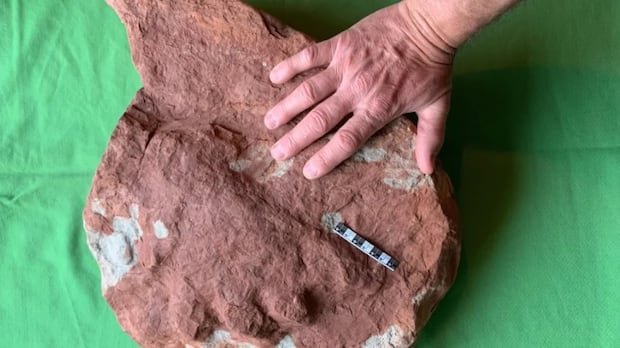Around 290 million years ago, an enormous reptile, potentially a Pareiasaur, traversed the shoreline of Hillsborough Bay in P.E.I., leaving behind a footprint that has recently been unearthed by local resident Patrick Brunet of North Rustico. The fossilized footprint, measuring 25 centimeters wide, is described as “remarkable” by the P.E.I. Museum and Heritage Foundation.
Believed to have been created by a Pareiasaur, a bulky herbivore with a knobby skull that could weigh up to one tonne, the discovery sheds light on the ancient creatures that inhabited the region during the Permian period, long before the existence of dinosaurs on Earth. During this era, when P.E.I. was located near the heart of the supercontinent Pangaea, Pareiasaurs were the largest creatures to roam the equatorial zones of the landmass.
This finding contributes to the expanding collection of fossils from prehistoric reptiles and amphibians that once populated the province millions of years ago. Notably, it could potentially be the oldest-known instance of this type of fossil footprint ever documented.
Patrick Brunet, a self-taught scientist, expressed his astonishment at the size and significance of the footprint, stating, “I knew immediately it came from a really big animal, and it was really important.”
The next phase following the discovery involves verifying whether the footprint indeed belongs to a Pareiasaur. Brunet will collaborate with an international team of scientists led by Dr. John Calder, the primary investigator and advisor to the P.E.I. Museum and Heritage Foundation, in conducting further research.
Dr. Calder highlighted the uniqueness of the finding, emphasizing that P.E.I. is poised to become a prominent site for fossil footprints from the land’s ancient life during this distinctive period in Earth’s history. The Island’s red rocks are hailed for preserving the most comprehensive record of the Permian era in Canada.
Upon completion of the study, the fossil discovered by Brunet will be repatriated to Prince Edward Island to be included in the provincial collection, solidifying the Island’s status alongside renowned sites in the U.S. and Europe for Permian Period discoveries.


